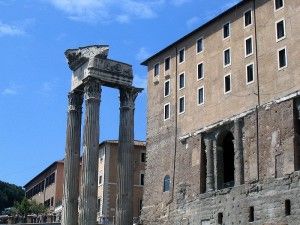History of Rome

While preparing for a trip to Rome, I downloaded Rick Steves' Rome 2014 guide. In his (intentionally) comically short history of the Eternal City, he wrote the following:
Ancient Rome lasted a thousand years (500 B.C.-A.D. 500), half as an expanding republic, half as a dominating empire. When Rome fell to invaders, all of Europe suffered a thousand years of poverty and ignorance (A.D. 500-1500), though Rome's influence could still be felt in the Catholic Church.
Now, since buying Steve's guide, I've learned that he might be something of a reprobate (click here to form your own half-baked opinion; and rest assured, my opinion on this matter is half-baked, based only on that link), but reprobatory or not, you'd hope for a little better historical knowledge from one of America's foremost travel guides.
Herein, my effort to re-write the passage without materially lengthening it:
Ancient Rome lasted a thousand years (500 B.C.-A.D. 500), half as an expanding republic, half as a dominating empire. When Rome fell, Europe suffered 500 years of poverty and much ignorance (A.D. 500-1000), though Rome's influence could still be felt in the Catholic Church. Europe and Rome began to climb out of these "Dark Ages" in 1000 A.D.
My justification for using 1000 A.D.? Simple: It's accurate. The Vikings and Magyars were no longer a threat. Commerce was increasing. Philosophy and theology were on the rise. Heck, by the 1100, Europe was growing so rich that Europe needed Saints Francis and Dominic to remind it of the virtues of poverty and the danger of riches.
And two brief points from the Wikipedia entry about the Eternal City: (1) "The lowest point was touched in 897, when a raging crowd exhumed the corpse of a dead pope, Formosus, and put it on trial." So, if the City bottomed out in 897, it's logical to assume it was on the rise during the 900s (nothing is static; everything is either growing or declining). (2) In this period [circa 1150] the renovated Church was again attracting pilgrims and prelates from all the Christian world, and money with them: even with a population of only 30,000, Rome was again becoming a city of consumers dependent upon the presence of a governmental bureaucracy."
By the way, the best travel book about Rome for a Catholic is Frank Korn's. See below.
